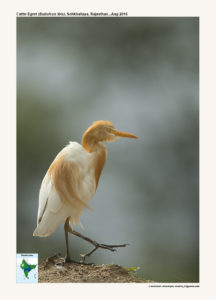Cattle-egret

Cattle Egret Bubulcus ibis
Etymology :
- Bubulcus : Latin word for Cowherd
- Ibis : Latin word for a white wading bird
Vernacular Names : Sind: Kurk pakkhi, Hindi: Surkhia/Badami/Dorai/Gai bagla, Sans: Go balaka, Pun: Badami bagla, Ben: Go bak, Gai bak, Ass: Go bog, Mani: San-dung-il, Guj: Dhor baglo/bagalo, Mar: Gochandi khao, Gai bagla, Ori: Gai baga, Ta: Unni kokku, Te: Samti konga, Mal: Kalimunti, Kan: Hasu ballakki, Janu ballakki, Sinh: Harak kokka
Distribution in India: Wide spread resident except for Himalayas and Rajasthan
Description:Size of 48-53 cm. They have a short thick neck, a sturdy bill, and a hunched posture. The non-breeding adult has mainly white plumage, a yellow bill and greyish-yellow legs. During the breeding season, adults develop orange-buff plumes on the back, breast and crown, and the bill, legs and irises become bright red for a brief period prior to pairing. The sexes are similar, but the male is marginally larger and has slightly longer breeding plumes than the female.
Habitat: It is found in fields and dry grassy habitats, near human settlements with grazing cattle. Also frequents shallow water, tanks and other small water bodies.
Food Habits: They eat wide range of prey, particularly insects, especially grasshoppers, crickets, flies , and moths, as well as spiders, frogs, and earthworms . They occasionally eat ripe figs.The species is usually found with cattle and other large grazing and browsing animals, and catches small creatures disturbed by the mammals
Breeding Habits: The cattle egret nests in colonies, which are often found around bodies of water. The colonies are usually found in woodlands near lakes or rivers, in swamps, or on small inland or coastal islands, and are sometimes shared with other wetland birds. The male displays in a tree in the colony, using a range of ritualized behaviour such as shaking a twig and sky-pointing (raising his bill vertically upwards), and the pair forms over three or four days. A new mate is chosen in each season and when re-nesting following nest failure. The nest is a small untidy platform of sticks in a tree or shrub constructed by both parents. Sticks are collected by the male and arranged by the female, and stick-stealing is rife. The clutch size can be anywhere from one to five eggs, Incubation lasts around 23 days, with both sexes sharing incubation duties. The chicks begin to leave the nest and climb around at 2 weeks, fledge at 30 days and become independent at around the 45th day.
The cattle egret engages in low levels of brood parasitism, by laying eggs in the nests of snowy egrets and little blue herons .They also engage in intraspecific brood parasitism, with females laying eggs in the nests of other cattle egrets.